The Tasks For Impressed Current on Concrete Restoration
The process of installing an impressed current cathodic protection system requires that each area of concrete be accessed many different times to perform the various tasks. Following is a list of some of the steps required to install a quality system:
1
Set-up Enclosure & Get Ventilation System Running
2
Perform a Primary Sand Blast
3
Surveys
- Locate Damaged Concrete – Sound with hammer & mark out boundaries of bad concrete
- Locate Near Surface Metal – Use metal detectors and visual inspection to locate and mark surface metals to be removed
- Locate Shallow Rebar – Use rebar covermeter to locate and mark shallow rebar to be excavated and covered




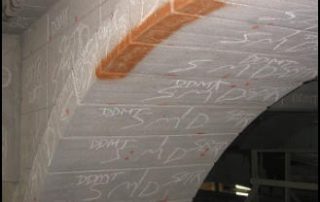
An area after completion of all surveys. The initials indicate that the surveys were done and by whom. The areas marked in orange are unsound concrete that needs to be repaired and the red marks indicate near surface metals that need to be removed.
4
Surface Metal Repair
- Drill out smaller surface metals & mark count
- Cut off large surface metals
- Patch Surface Metal holes & count
- Inspect patches after 24-72 hour cure time



5
Concrete Repair
- Saw cut boundary of concrete repair area
- Chip out bad concrete & ensure proper profile
- Drill holes for anchors as needed
- Apply epoxy and insert anchors in holes
- Clean-up any extra epoxy from anchor holes
- Sand blast patch area
- Pre-wet patch area for 24 hours prior to patching
- Drill holes and install anchors around patch perimeter to hold forms
- Install Concrete form
- Patch repair area and allow to cure
- Remove form boards
- Remove form anchors
- Apply epoxy and plug form anchor holes
- Grind off any excess concrete from port hole
- Sound concrete patch for delaminations (if any found, repeat repair process for that area)
- Measure patches and record for payment
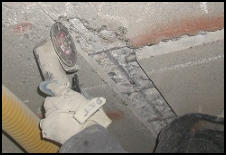


6
Shallow Bar Repair
- Same as Concrete repair above, except build special build-up form for additional concrete cover and
- Check that cover is adequate after patch is complete
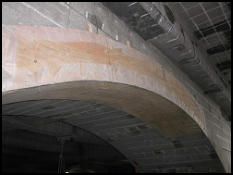
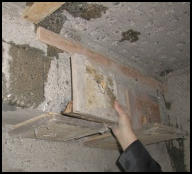
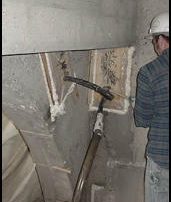
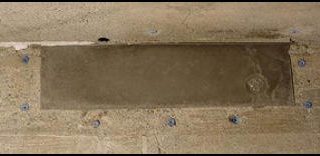
7
Rebar Continuity
- Test every rebar that is exposed by concrete removal for continuity & mark discontinuous bars
- Test covered bars selected by Owner per specifications:
- Locate rebar with covermeter
- Drill access hole to rebar
- Test rebar and record reading
- Patch access hole
- Test adjacent bars to determine best approach to establish continuity
- Establish continuity
- Test to ensure continuity has been established
- Record continuity tests, excavations, and continuity establishments for payment


8
Reference Electrodes
- Mark out grid for taking potentials
- Take potential readings
- Analyze potential data and select small grid potential locations
- Perform small grid potential survey to select reference electrode location:
- Locate rebar
- Mark out grid along rebar
- Take readings & record
- Measure location and map out
- Analyze small grid potential maps and select reference electrode location
- Submit potential data & recommendation for reference electrode location to Owner for approval
- After receiving approval from Owner, Excavate for reference electrode:
- Verify Rebar location and depth
- Excavate for negative installation
- Excavate for cell installation
- Excavate for test well
- Plant reference electrode
- Weld system negative to rebar in reference electrode negative location
- Pre-wet negative location for 24 hours prior to patching
- Patch reference cell negative
- Install test well conduit and cap
- Test reference cell function after adequate cure time


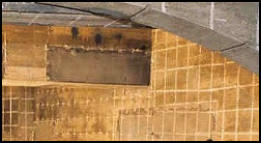
9
Blasting & Zincing
- Ensure negative air and heating system is operating & that concrete surface temp and humidity requirements have been reached
- Sandblast concrete surface
- Mask zone boundaries and any exposed metal brackets or pipes, etc.
- Spray zinc and test millage during production
- Do pull-tests to ensure adequate bond strength
- Spray zinc to touch-up pull test locations
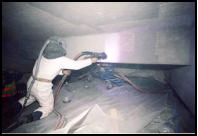


10
Electrical
- Drill holes for anchors to secure conduit or hang header run
- Install Conduit and anchors
- Pull wires
- Label wires
- Test wires per specifications



